100 Language Processing Knock 2020 Chapter 7: Word Vector
The other day, 100 Language Processing Knock 2020 was released. I myself have only been in natural language processing for a year, and I don't know the details, but I will solve all the problems and publish them in order to improve my technical skills.
All shall be executed on jupyter notebook, and the restrictions of the problem statement may be broken conveniently. The source code is also on github. Yes.
Chapter 6 is here.
The environment is Python 3.8.2 and Ubuntu 18.04.
Chapter 7: Word Vector
Create a program that performs the following processing for a word vector (word embedding) that expresses the meaning of a word as a real vector.
Please download the required dataset from here.
The downloaded file shall be placed under data.
60. Reading and displaying word vectors
Download the learned word vector (3 million words / phrases, 300 dimensions) in the Google News dataset (about 100 billion words) and display the word vector of "United States". However, note that "United States" is internally referred to as "United_States".
Use gensim.
code
from gensim.models import KeyedVectors
code
model = KeyedVectors.load_word2vec_format('data/GoogleNews-vectors-negative300.bin.gz', binary=True)
code
model["United_States"]
output
array([-3.61328125e-02, -4.83398438e-02, 2.35351562e-01, 1.74804688e-01,
-1.46484375e-01, -7.42187500e-02, -1.01562500e-01, -7.71484375e-02,
1.09375000e-01, -5.71289062e-02, -1.48437500e-01, -6.00585938e-02,
1.74804688e-01, -7.71484375e-02, 2.58789062e-02, -7.66601562e-02,
-3.80859375e-02, 1.35742188e-01, 3.75976562e-02, -4.19921875e-02,
-3.56445312e-02, 5.34667969e-02, 3.68118286e-04, -1.66992188e-01,
-1.17187500e-01, 1.41601562e-01, -1.69921875e-01, -6.49414062e-02,
-1.66992188e-01, 1.00585938e-01, 1.15722656e-01, -2.18750000e-01,
-9.86328125e-02, -2.56347656e-02, 1.23046875e-01, -3.54003906e-02,
-1.58203125e-01, -1.60156250e-01, 2.94189453e-02, 8.15429688e-02,
6.88476562e-02, 1.87500000e-01, 6.49414062e-02, 1.15234375e-01,
-2.27050781e-02, 3.32031250e-01, -3.27148438e-02, 1.77734375e-01,
-2.08007812e-01, 4.54101562e-02, -1.23901367e-02, 1.19628906e-01,
7.44628906e-03, -9.03320312e-03, 1.14257812e-01, 1.69921875e-01,
-2.38281250e-01, -2.79541016e-02, -1.21093750e-01, 2.47802734e-02,
7.71484375e-02, -2.81982422e-02, -4.71191406e-02, 1.78222656e-02,
-1.23046875e-01, -5.32226562e-02, 2.68554688e-02, -3.11279297e-02,
-5.59082031e-02, -5.00488281e-02, -3.73535156e-02, 1.25976562e-01,
5.61523438e-02, 1.51367188e-01, 4.29687500e-02, -2.08007812e-01,
-4.78515625e-02, 2.78320312e-02, 1.81640625e-01, 2.20703125e-01,
-3.61328125e-02, -8.39843750e-02, -3.69548798e-05, -9.52148438e-02,
-1.25000000e-01, -1.95312500e-01, -1.50390625e-01, -4.15039062e-02,
1.31835938e-01, 1.17675781e-01, 1.91650391e-02, 5.51757812e-02,
-9.42382812e-02, -1.08886719e-01, 7.32421875e-02, -1.15234375e-01,
8.93554688e-02, -1.40625000e-01, 1.45507812e-01, 4.49218750e-02,
-1.10473633e-02, -1.62353516e-02, 4.05883789e-03, 3.75976562e-02,
-6.98242188e-02, -5.46875000e-02, 2.17285156e-02, -9.47265625e-02,
4.24804688e-02, 1.81884766e-02, -1.73339844e-02, 4.63867188e-02,
-1.42578125e-01, 1.99218750e-01, 1.10839844e-01, 2.58789062e-02,
-7.08007812e-02, -5.54199219e-02, 3.45703125e-01, 1.61132812e-01,
-2.44140625e-01, -2.59765625e-01, -9.71679688e-02, 8.00781250e-02,
-8.78906250e-02, -7.22656250e-02, 1.42578125e-01, -8.54492188e-02,
-3.18359375e-01, 8.30078125e-02, 6.34765625e-02, 1.64062500e-01,
-1.92382812e-01, -1.17675781e-01, -5.41992188e-02, -1.56250000e-01,
-1.21582031e-01, -4.95605469e-02, 1.20117188e-01, -3.83300781e-02,
5.51757812e-02, -8.97216797e-03, 4.32128906e-02, 6.93359375e-02,
8.93554688e-02, 2.53906250e-01, 1.65039062e-01, 1.64062500e-01,
-1.41601562e-01, 4.58984375e-02, 1.97265625e-01, -8.98437500e-02,
3.90625000e-02, -1.51367188e-01, -8.60595703e-03, -1.17675781e-01,
-1.97265625e-01, -1.12792969e-01, 1.29882812e-01, 1.96289062e-01,
1.56402588e-03, 3.93066406e-02, 2.17773438e-01, -1.43554688e-01,
6.03027344e-02, -1.35742188e-01, 1.16210938e-01, -1.59912109e-02,
2.79296875e-01, 1.46484375e-01, -1.19628906e-01, 1.76757812e-01,
1.28906250e-01, -1.49414062e-01, 6.93359375e-02, -1.72851562e-01,
9.22851562e-02, 1.33056641e-02, -2.00195312e-01, -9.76562500e-02,
-1.65039062e-01, -2.46093750e-01, -2.35595703e-02, -2.11914062e-01,
1.84570312e-01, -1.85546875e-02, 2.16796875e-01, 5.05371094e-02,
2.02636719e-02, 4.25781250e-01, 1.28906250e-01, -2.77099609e-02,
1.29882812e-01, -1.15722656e-01, -2.05078125e-02, 1.49414062e-01,
7.81250000e-03, -2.05078125e-01, -8.05664062e-02, -2.67578125e-01,
-2.29492188e-02, -8.20312500e-02, 8.64257812e-02, 7.61718750e-02,
-3.66210938e-02, 5.22460938e-02, -1.22070312e-01, -1.44042969e-02,
-2.69531250e-01, 8.44726562e-02, -2.52685547e-02, -2.96630859e-02,
-1.68945312e-01, 1.93359375e-01, -1.08398438e-01, 1.94091797e-02,
-1.80664062e-01, 1.93359375e-01, -7.08007812e-02, 5.85937500e-02,
-1.01562500e-01, -1.31835938e-01, 7.51953125e-02, -7.66601562e-02,
3.37219238e-03, -8.59375000e-02, 1.25000000e-01, 2.92968750e-02,
1.70898438e-01, -9.37500000e-02, -1.09375000e-01, -2.50244141e-02,
2.11914062e-01, -4.44335938e-02, 6.12792969e-02, 2.62451172e-02,
-1.77734375e-01, 1.23046875e-01, -7.42187500e-02, -1.67968750e-01,
-1.08886719e-01, -9.04083252e-04, -7.37304688e-02, 5.49316406e-02,
6.03027344e-02, 8.39843750e-02, 9.17968750e-02, -1.32812500e-01,
1.22070312e-01, -8.78906250e-03, 1.19140625e-01, -1.94335938e-01,
-6.64062500e-02, -2.07031250e-01, 7.37304688e-02, 8.93554688e-02,
1.81884766e-02, -1.20605469e-01, -2.61230469e-02, 2.67333984e-02,
7.76367188e-02, -8.30078125e-02, 6.78710938e-02, -3.54003906e-02,
3.10546875e-01, -2.42919922e-02, -1.41601562e-01, -2.08007812e-01,
-4.57763672e-03, -6.54296875e-02, -4.95605469e-02, 2.22656250e-01,
1.53320312e-01, -1.38671875e-01, -5.24902344e-02, 4.24804688e-02,
-2.38281250e-01, 1.56250000e-01, 5.83648682e-04, -1.20605469e-01,
-9.22851562e-02, -4.44335938e-02, 3.61328125e-02, -1.86767578e-02,
-8.25195312e-02, -8.25195312e-02, -4.05273438e-02, 1.19018555e-02,
1.69921875e-01, -2.80761719e-02, 3.03649902e-03, 9.32617188e-02,
-8.49609375e-02, 1.57470703e-02, 7.03125000e-02, 1.62353516e-02,
-2.27050781e-02, 3.51562500e-02, 2.47070312e-01, -2.67333984e-02],
dtype=float32)
61. Word similarity
Calculate the cosine similarity between "United States" and "U.S.".
code
model.similarity("United_States", "U.S.")
output
0.73107743
62. 10 words with high similarity
Output 10 words with high cosine similarity to “United States” and their similarity.
code
import numpy as np
import pandas as pd
code
simularities = model.most_similar("United_States")
pd.DataFrame(
simularities,
columns = ['word', 'Degree of similarity'],
index = np.arange(len(simularities)) + 1
)
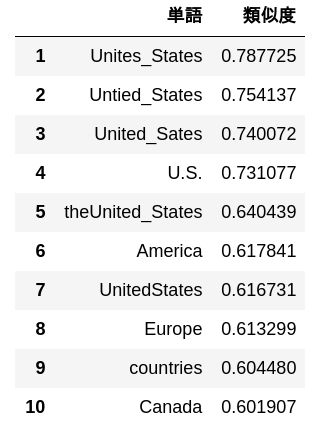
63. Analogy by additive construct
Subtract the "Madrid" vector from the "Spain" word vector, calculate the vector by adding the "Athens" vector, and output 10 words with high similarity to that vector and their similarity.
code
simularities = model.most_similar(positive=['Spain', 'Athens'], negative=['Madrid'])
pd.DataFrame(
simularities,
columns = ['word', 'Degree of similarity'],
index = np.arange(len(simularities)) + 1
)
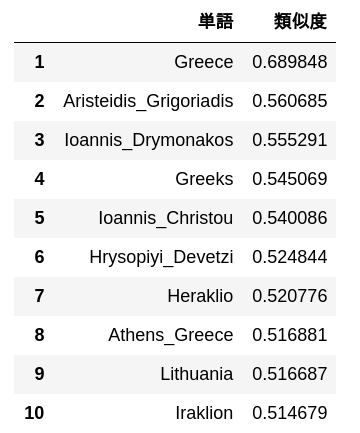
64. Experiments with analogy data
Download the evaluation data of the word analogy, calculate vec (word in the second column) --vec (word in the first column) + vec (word in the third column), and find the word with the highest similarity to the vector. , Find the similarity. Add the obtained word and similarity to the end of each case.
code
with open('data/questions-words.txt') as f:
lines = f.read().splitlines()
dataset = []
category = None
for line in lines:
if line.startswith(':'):
category = line[2:]
else:
lst = [category] + line.split(' ')
dataset.append(lst)
code
pd.DataFrame(dataset[:10])
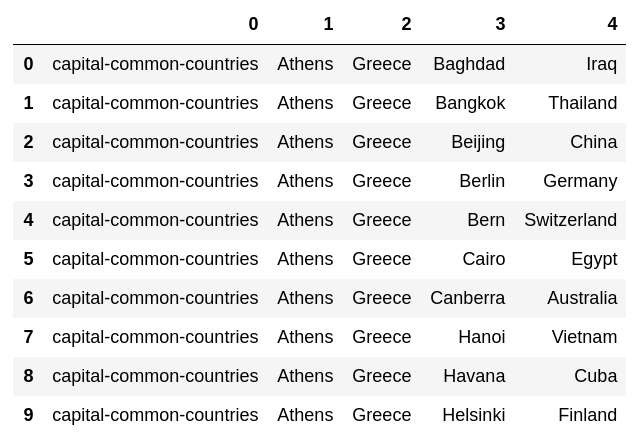
code
from tqdm import tqdm
code
for i, lst in enumerate(tqdm(dataset)):
pred, prob = model.most_similar(positive = lst[2:4], negative = lst[1:2], topn = 1)[0]
dataset[i].append(pred)
code
pd.DataFrame(dataset[:10])
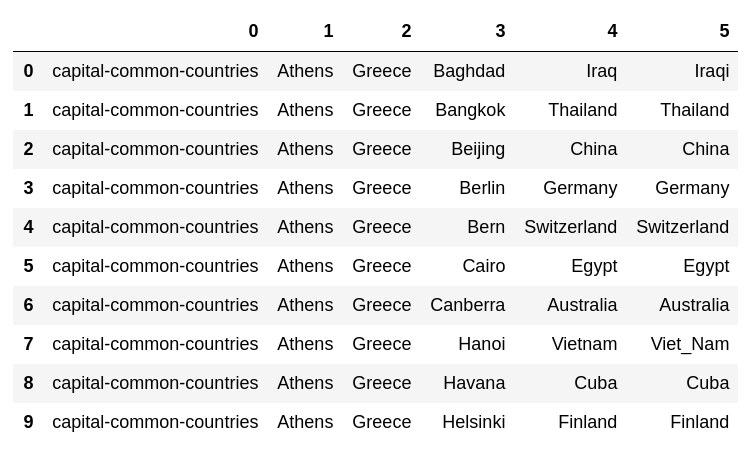
65. Correct answer rate in analogy tasks
Measure the accuracy rate of the semantic analogy and the syntactic analogy using the execution results of> 64.
The theory that evaluate_word_analogies () should be used is widely known.
code
semantic_analogy = [lst[-2:] for lst in dataset if not lst[0].startswith('gram')]
syntactic_analogy = [lst[-2:] for lst in dataset if lst[0].startswith('gram')]
code
acc = np.mean([true == pred for true, pred in semantic_analogy])
print('Semantic analogy correct answer rate:', acc)
output
Semantic analogy correct answer rate: 0.7308602999210734
code
acc = np.mean([true == pred for true, pred in syntactic_analogy])
print('Literary analogy correct answer rate:', acc)
output
Literary analogy correct answer rate: 0.7400468384074942
66. Evaluation by WordSimilarity-353
Download the evaluation data of The WordSimilarity-353 Test Collection and calculate the Spearman correlation coefficient between the ranking of similarity calculated by the word vector and the ranking of human similarity judgment.
code
import zipfile
code
#Read from zip file
with zipfile.ZipFile('data/wordsim353.zip') as f:
with f.open('combined.csv') as g:
data = g.read()
#Decode byte sequence
data = data.decode('UTF-8').splitlines()
data = data[1:]
#Tab delimited
data = [line.split(',') for line in data]
len(data)
output
353
code
for i, lst in enumerate(data):
sim = model.similarity(lst[0], lst[1])
data[i].append(sim)
code
pd.DataFrame(
data[:10],
columns = ['Word 1', 'Word 2', 'Human', 'vector']
)
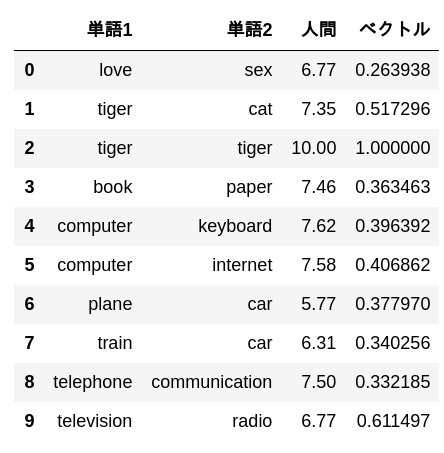
code
from scipy.stats import spearmanr
It is possible to apply argsort twice to get the ranking, but it may be useless in terms of calculation amount.
code
def rank(x):
args = np.argsort(-np.array(x))
rank = np.empty_like(args)
rank[args] = np.arange(len(x))
return rank
code
human = [float(lst[2]) for lst in data]
w2v = [lst[3] for lst in data]
human_rank = rank(human)
w2v_rank = rank(w2v)
rho, p_value = spearmanr(human_rank, w2v_rank)
output
Rank correlation coefficient: 0.700313895424209
p-value: 2.4846350292113526e-53
code
print('Rank correlation coefficient:', rho)
print('p-value:', p_value)
code
import matplotlib.pyplot as plt
code
plt.scatter(human_rank, w2v_rank)
plt.show()
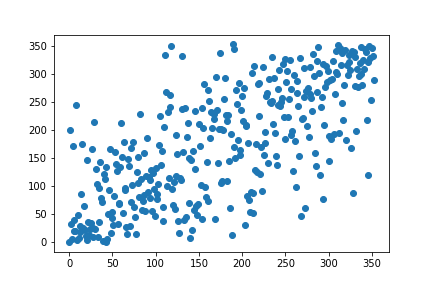
67. k-means clustering
Extract the word vector related to the country name and execute k-means clustering with the number of clusters k = 5.
I'm not sure where to get the country name from, but the analogy dataset does a good job
code
countries = {
country
for lst in dataset
for country in [lst[2], lst[4]]
if lst[0] in {'capital-common-countries', 'capital-world'}
} | {
country
for lst in dataset
for country in [lst[1], lst[3]]
if lst[0] in {'currency', 'gram6-nationality-adjective'}
}
countries = list(countries)
len(countries)
output
129
code
country_vectors = [model[country] for country in countries]
code
from sklearn.cluster import KMeans
code
kmeans = KMeans(n_clusters=5)
kmeans.fit(country_vectors)
output
KMeans(algorithm='auto', copy_x=True, init='k-means++', max_iter=300,
n_clusters=5, n_init=10, n_jobs=None, precompute_distances='auto',
random_state=None, tol=0.0001, verbose=0)
code
for i in range(5):
cluster = np.where(kmeans.labels_ == i)[0]
print('class', i)
print(', '.join([countries[k] for k in cluster]))
output
Class 0
Suriname, Honduras, Tuvalu, Guyana, Venezuela, Peru, Cuba, Ecuador, Nicaragua, Dominica, Colombia, Belize, Mexico, Bahamas, Jamaica, Chile
Class 1
Netherlands, Egypt, France, Syria, Finland, Germany, Uruguay, Switzerland, Greenland, Italy, Lebanon, Malta, Algeria, Europe, Tunisia, Brazil, Ireland, England, Libya, Spain, Argentina, Liechtenstein, Iran, Jordan, USA, Iceland, Sweden, Norway, Qatar, Portugal, Denmark, Canada, Israel, Belgium, Morocco, Austria
Class 2
Kazakhstan, Lithuania, Turkmenistan, Serbia, Croatia, Greece, Uzbekistan, Armenia, Latvia, Albania, Slovenia, Cyprus, Ukraine, Georgia, Belarus, Bulgaria, Kyrgyzstan, Macedonia, Estonia, Montenegro, Turkey, Azerbaijan, Tajikistan, Poland, Russia, Romania, Hungary, Slovakia, Moldova
Class 3
Ghana, Senegal, Zambia, Sudan, Somalia, Zimbabwe, Gabon, Madagascar, Angola, Liberia, Gambia, Niger, Uganda, Mauritania, Namibia, Eritrea, Botswana, Malawi, Mozambique, Guinea, Kenya, Nigeria, Burundi, Mali, Rwanda
Class 4
Japan, China, Pakistan, Samoa, Bahrain, Fiji, Australia, India, Laos, Bhutan, Malaysia, Taiwan, Cambodia, Nepal, Korea, Oman, Thailand, Bangladesh, Indonesia, Iraq, Vietnam, Afghanistan, Philippines
They are divided.
68. Ward's method clustering
Execute hierarchical clustering by Ward's method for word vectors related to country names. Furthermore, visualize the clustering result as a dendrogram.
code
from scipy.cluster.hierarchy import dendrogram, linkage
code
plt.figure(figsize=(16, 9), dpi=200)
Z = linkage(country_vectors, method='ward')
dendrogram(Z, labels = countries)
plt.show()
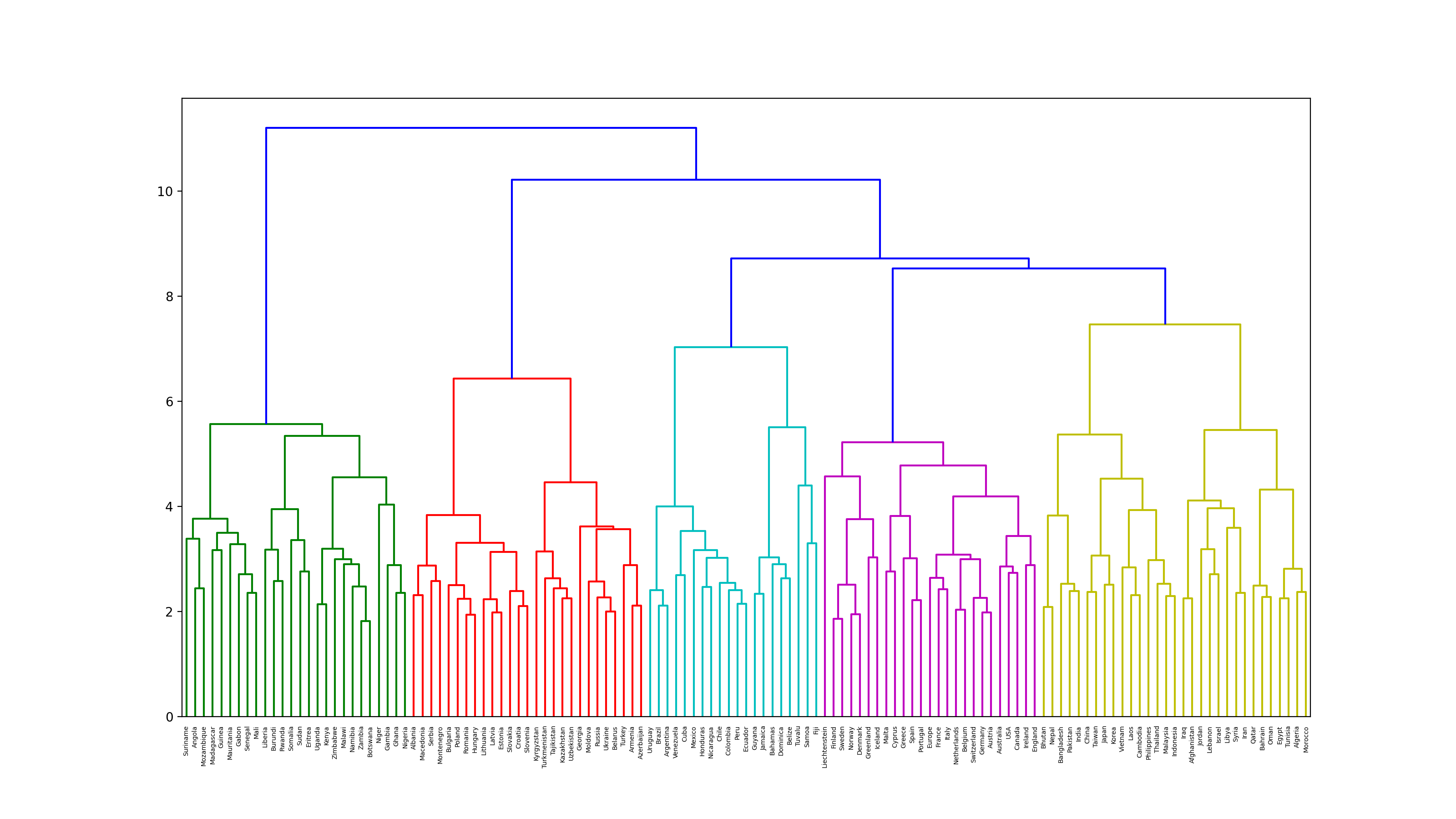
69. Visualization by t-SNE
Visualize the vector space of word vectors related to country names with t-SNE.
code
from sklearn.manifold import TSNE
code
tsne = TSNE()
tsne.fit(country_vectors)
output
TSNE(angle=0.5, early_exaggeration=12.0, init='random', learning_rate=200.0,
method='barnes_hut', metric='euclidean', min_grad_norm=1e-07,
n_components=2, n_iter=1000, n_iter_without_progress=300, n_jobs=None,
perplexity=30.0, random_state=None, verbose=0)
code
plt.figure(figsize=(15, 15), dpi=300)
plt.scatter(tsne.embedding_[:, 0], tsne.embedding_[:, 1])
for (x, y), name in zip(tsne.embedding_, countries):
plt.annotate(name, (x, y))
plt.show()
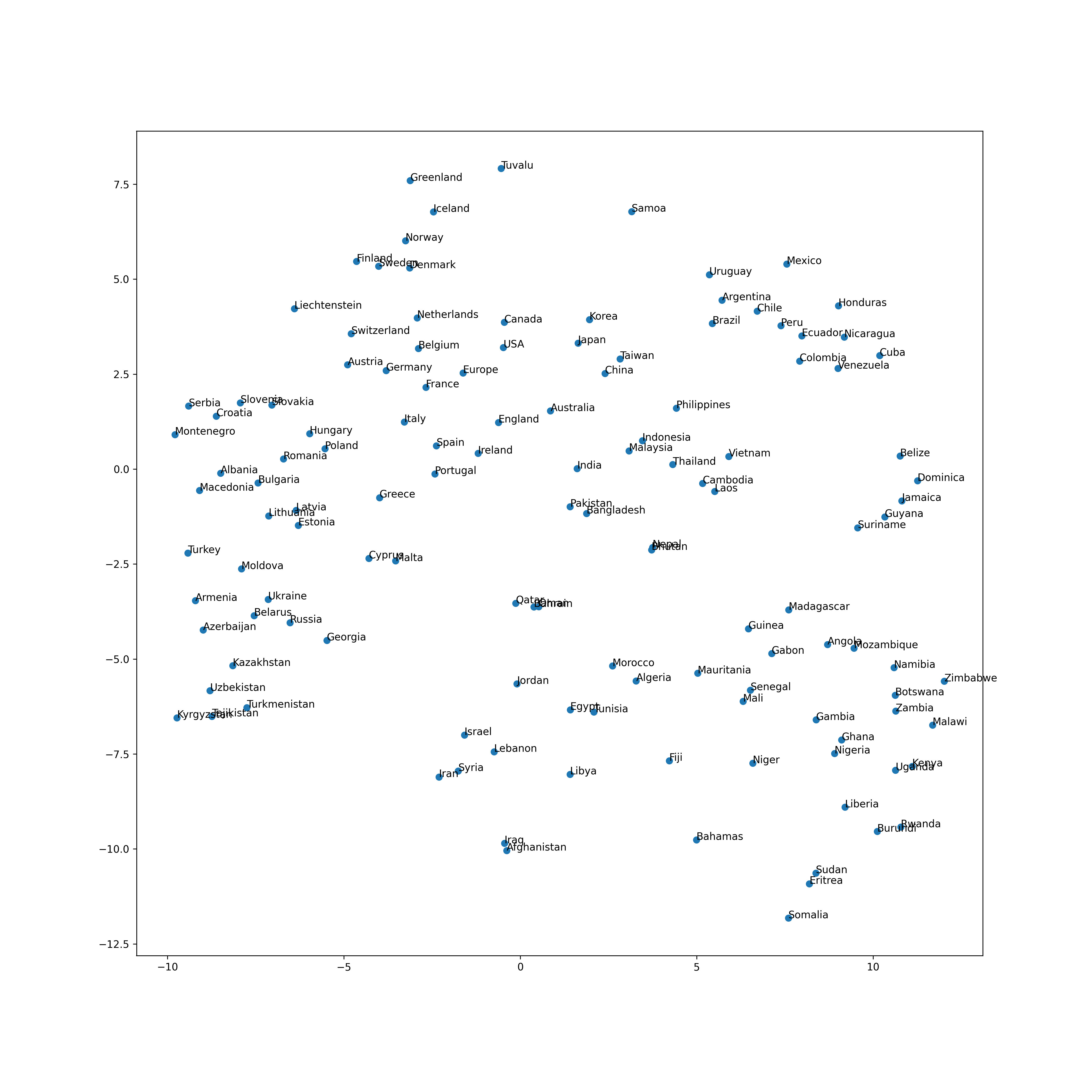
Next is Chapter 8
Language processing 100 knocks 2020 Chapter 8: Neural network
Recommended Posts